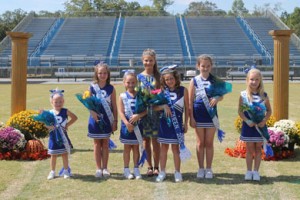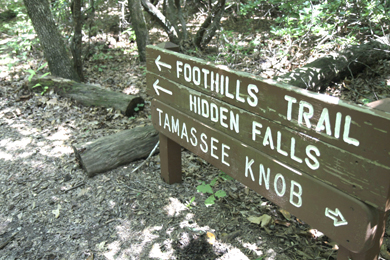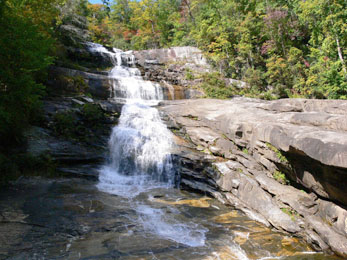Category Archives: Lifestyles
Pickens Rec Report
By Cheri Anthony
Pickens Rec Director
canthony@pickenscity.com
I want to begin by thanking our football and cheerleading participants who came to Rec. Night at the Pickens High School vs Liberty game on

Winners, from left: Princesses Katie-Ann Acuff, Alli Morgan and Kayleigh Seaborn, Spririt Queen Hannah Chapman, Princesses Aelina Williams and Alli Morgan. Back row: 2014 Spirit Queen Isabelle Caroline Harris.
Friday, September 4. The kids who attended received a miniature football as a thank youJ Parents, thank you for bringing your children and supporting our events!
A huge thank you to all the volunteers who made Super Saturday so successful! The weather was perfect which made the festivities fun for all! Also, thanks to all the parents who were so supportive of the children and to our neighbors from Anderson who came to play football!
I apologize for the scheduling changes.
I would like to commend the Spirit Queen participants. The combined efforts of these 12 young ladies raised $768.49 which will go towards our scholarship program. Way to go ladies!!! The Spirit Queen contestants and their escorts were as follows: Abbigail Porter was escorted by Ryan Ford; Ella Grace Boynton was escorted by Bryson Harris; Natalie Boggs was escorted by Chann Gray; Alli Morgan was escorted by her father, Micky Morgan; Kaydence Bell was escorted by Griffin Duncan; Hannah Chapman was escorted by Trevor McAlister; Ally Gilstrap was escorted by her brothers, Elijah Taylor and Alex Gilstrap; Aelina Williams was escorted by her father, Sam Williams; Gracie Lusk was escorted by her brother, Gradie Lusk; Kayleigh Seaborn and Katie Ann Acuff were escorted by their brother Zachary Seaborn-Acuff; Amber Saitta was escorted by Drew Freeman; and Ashlyn Knight was escorted by her brother, Xander Knight. Congratulations ladies on a job well done!!!
Princess winners this year were Miss Alli Morgan, Aelina Williams, Ally Gilstrap, Katie Ann Acuff and Kayleigh Seaborn.
Our 2015 Pickens Recreation Spirit Queen was Miss Hannah Chapman! Crowning our winner this year was our reigning 2014 Spirit Queen, Miss Isabelle Caroline Harris.
Sponsoring a day-long event of this magnitude requires the support of many volunteers. We would like to thank the following individuals for helping to make Super Saturday a success. We will try and acknowledge those who were so instrumental, but please forgive us in advance for any oversights! A tremendous thank you to our concession gang: Crystal and Caitlin Miller, Scott and Lori Hanson, Kayla Underwood, Chad, Lydia and Ansley Trotter, Jane Tinsley, Laura Pace, Stephanie Ramey and Rick Chappell; press box duties: Marty Harris and Dewayne Bennett; clock operator: Robert Patterson; Spirit Queen Pageant helpers: Patti Roach and Nancy Ford; and a special thank you to all those who stayed to help with trash detail. Thanks to Lowes of Easley for the beautiful mums that were used in our Spirit Queen presentation. Finally, last but not least, thanks to Stan Butler, John Boggs and Pickens High School for the use of the stadium. As always, thank you parents for being such a great support group! We appreciate you allowing us to “have fun with” and know your beautiful children!
Following Super Saturday, the Rec. Dept. hosted a community NFL Punt, Pass and Kick Competition. Boys and girls between the ages of 6 to 15 were welcome to compete. Winners in each age division were as follows: 8/9 boys-1st-Carter McCollum; 12/13 girls 1st-Ally Niles; 14/15 girls 1st-Alexis Holliday. The 1st place winners in each division will now advance to the sectional competition on Oct. 24 at Greenville High School. Congratulations to all participants and good luck to those who advanced! A big thank you to Scott Kelley who stayed and helped with the competition.
Come visit our booth this year at the 2015 Pumpkin Festival. We will again be serving hotdogs, nachos, sno-cones and pickles with all proceeds going towards Rec. Dept. projects. This year’s festival is planned for Saturday, October 10. See you there!
Mark your calendars now, basketball registration begins in October.
Until next time…
Gilstrap honored with Quilt of Valor
With his children and family members present, Ernest Gaines Gilstrap, Seamen Second Class USS Massachusetts U.S. Navy (1942-1945) was awarded the Quilt of Valor for WWII veterans on Aug. 22 in  Liberty. Anne Medlin (member of the Quilt of Valor Anderson) presented him with this very unique quit designed especially for him. The quilt was very special to Medlin because her father, James Day, had served with Gilstrap aboard the USS Massachusetts from (1942-1945). Gilstrap was born July 7, 1927, to the late William Henry and Elsie Akin Gilstrap in Liberty. He tells the story of being a young mischievous teenager, and at the age of 15 and two months, he revised his birth certificate to show he was 17, which was the minimum age for enlistment for the Navy. When he finished bootcamp in Norfolk, Va., he went aboard the USS Massachusetts in Casco Bay, Maine, on Oct. 24, 1942. The next day they weighed anchor for the invasion of North Africa at Casablanca. The Massachusetts was hit three times by enemy fire with little damage and no loss of life. The ship and crew were awarded the battle star for the European/African theater of war and battle stars for the Pacific theater of war. As a member of the Naval landing force, he went ashore in Tokyo Bay on Aug. 26, 1945, and helped unarm the Japanise and sailed past the USS Missouri as they were signing the surrender. Gilstrap was honorably discharged in Dec. 20, 1942.
Liberty. Anne Medlin (member of the Quilt of Valor Anderson) presented him with this very unique quit designed especially for him. The quilt was very special to Medlin because her father, James Day, had served with Gilstrap aboard the USS Massachusetts from (1942-1945). Gilstrap was born July 7, 1927, to the late William Henry and Elsie Akin Gilstrap in Liberty. He tells the story of being a young mischievous teenager, and at the age of 15 and two months, he revised his birth certificate to show he was 17, which was the minimum age for enlistment for the Navy. When he finished bootcamp in Norfolk, Va., he went aboard the USS Massachusetts in Casco Bay, Maine, on Oct. 24, 1942. The next day they weighed anchor for the invasion of North Africa at Casablanca. The Massachusetts was hit three times by enemy fire with little damage and no loss of life. The ship and crew were awarded the battle star for the European/African theater of war and battle stars for the Pacific theater of war. As a member of the Naval landing force, he went ashore in Tokyo Bay on Aug. 26, 1945, and helped unarm the Japanise and sailed past the USS Missouri as they were signing the surrender. Gilstrap was honorably discharged in Dec. 20, 1942.
Community Calendar 9-16-15
• Soapstone to host fundraiser Saturday
Soapstone Church is inviting everyone to a special fundraiser at the church, located at 296 Liberia Road in Pickens, this Saturday, Sept. 19. The event will feature fine cooking and will be held from noon-8 p.m.
Visitors will enjoy true Southern cooking including a fish fry, barbecue and fried chicken with all the fixings right from Mrs. Mabel’s kitchen.
For more information, call (864) 414-8470.
• Children’s Fall Festival set in Easley
The city of Easley and Gilstrap Family Dealerships will host a Children’s Fall Festival on Saturday, Oct. 31, from 4-8 p.m.
The event will be held around the downtowwn merchants and at Old Market Square in Easley. Children can trick or treat with the downtown merchants and then join a fun-filled festival with games, music, costume contests and more. The festival is free.
For more, visit easleyevents.com or call (864) 423-4344.
• Winchester reunion set for September 20
The annual Winchester reunion will be held at the Shady Grove Baptist Church Fellowship Building on Sunday, Sept. 20, at 12:15 p.m.
Table accessories will be provided. Each family will provide food and drinks.
There will be a memorial candlelight service for those who passed away during the past years and a video to portray the 70th wedding anniversary of Jack and Sheila Winchester of Florida. Hough Pace is president, Dale Winchester is vice president and David Winchester and his daughter are serving as treasurer and secretary.
• Pickens Lions plan meetings each month
The Pickens Lions Club is in need of new members. The club meets the first and third Thursday of every month at Pizza Inn in Pickens. Dinner begins at 6:40 p.m., and the meeting starts at 7 p.m.
Meetings are open to anyone interested in joining the club or simply finding out more about the club and how it serves Pickens.
• Chastain family to hold reunion
Descendents and friends of Oscar and Bertha Chastain are invited to meet at Holly Springs Baptist Church Fellowship Hall Sunday Sept. 20, at 1p.m. for a covered dish lunch and reunion fellowship
Hudson reunion set for August 23
EASLEY — The annual Macajah Hudson reunion will be held August 23 at the Moose Lodge on S.C. Highway 8 west of Easley.
Lunch will be at 1 p.m. Paper goods and ice will be furnished.
All friends and relatives are urged to attend.
How to help kids make the transition back to the classroom

The dawn of a new school year is an exciting time. Kids may not want to say goodbye to days spent lounging by the pool, but such disappointment is often

As a new school year draws nearer, parents can employ several strategies to help their kids readjust to the rigors of the classroom.
[cointent_lockedcontent]tempered by the prospect of returning to school with friends.
For parents, getting kids ready for a new school year is about more than updating their wardrobe or organizing carpools with fellow parents. Reacclimating kids to the routine of school after a relaxing summer is a significant undertaking, and the following are a handful of ways for parents to get a head start as the school year draws closer.
• Establish a routine over the last few weeks of summer. Summer vacations typically lack the structure of the school year, and that lack of structure can help kids unwind and make the most of the freedom that summer vacation provides. But as summer starts to wind down, parents can begin to reintroduce some structure into their kids’ lives to make the transition back to school go more smoothly. Plan morning activities so kids can readjust to waking up early each day. In addition, serve breakfast, lunch and dinner at the same time you typically serve it during the school year so kids’ bodies can begin to readjust as well.
• Take kids along when shopping for school supplies. If you plan to buy your child a new computer or other supplies for the upcoming school year, take him or her along on your shopping trips. Kids who get to choose their supplies might be more excited about returning to school than those youngsters who are given what they need without offering their input.
• Monitor or assign summer reading. Many students are given summer reading lists to keep their minds sharp over the summer and prepare them for upcoming coursework. Parents should monitor kids’ progress on such reading lists and even discuss the books with their kids when possible. Read the books along with them if you think it will help engage them. If kids were not assigned summer reading lists at the end of the school year, assign your own books, rewarding kids when they finish a new book. Kids who read throughout the summer may be more likely to start the school year off on the right foot than those who don’t crack a book all summer.
• Encourage kids to sign up for extracurricular activities. Many school-aged athletes get a head start on the new school year by trying out for sports teams. Such tryouts often commence a week or two before a school year is scheduled to begin, and this can help kids ease their way back into the school year. But even nonathletes can begin pursuing extracurricular activities before the first school bell of the year rings. Theater programs may begin auditions or encourage interested youngsters to attend orientation meetings before the dawn of the school year, and such sessions can be a great and pressure-free way for kids to ready themselves for a new school year.
The arrival of a new school year can be both exciting and daunting. But parents can help their youngsters readjust to school in various ways after a relaxing summer.
[/cointent_lockedcontent]
How to save on school supplies
Back to school season can be as expensive for parents as it is exciting for students.

School supplies can be expensive, but parents can employ several strategies to save on supplies now and in the future.
Once the initial letdown of the end of summer vacation wears off, many kids are excited to return to school, where they can see their friends, study their favorite subjects and participate in extracurricular activities.
[cointent_lockedcontent]Parents of school-aged youngsters may share in that excitement while also knowing that back to school season can stretch their budgets. One of the ways to salvage those budgets is to save on school supplies. Fortunately, there are several ways parents can do just that.
• Be patient. Shopping early can save shoppers money in many instances, but parents may benefit by exercising patience when it comes to buying school supplies for their children. Teachers often give students lists of supplies they will need for each class, and parents who wait to receive such lists can avoid spending money on items their kids won’t need. Even if you wait it out, you may be able to get a head start, as some teachers may post supply lists on school websites, while others might email lists to parents before back to school season hits full swing.
• Take inventory. If you have more than one child, chances are you already have lots of school supplies around the house. Dust off kids’ backpacks and study areas from last school year to determine which supplies you need to buy and which you already have. Going forward, encourage kids to store their supplies in a predetermined area once the school year ends, as this will make next year’s inventory that much easier to examine and assess.
• Spend more now to save later. While inexpensive supplies can be hard to resist, such items likely won’t withstand the test of time, forcing you to spend time and money each year buying replacement supplies. Paying more now for certain items, including stronger backpacks and more highly rated calculators, may end up saving you money in the long run, even if the initial pill is somewhat tough to swallow.
• Use technology to your advantage. Department stores and businesses that sell school supplies, such as pharmacies and office stores, may or may not discount too many items once back to school season hits full swing. But savvy parents can still find deals by using technology to their advantage when shopping for school supplies. Download apps like RetailMeNot to your smartphone and enable its updates so your phone essentially notifies you of any discounts the moment you walk into a given store. If you don’t receive any updates, search for discounts via the app or the Internet as you shop. Chances are strong that there are deals to be had, even if you don’t learn of the deals until you arrive at the store.[/cointent_lockedcontent]
Add health screenings to back-to-school checklist
As summer vacation winds down, thoughts turn from jaunts to the beach to readying for a new school year. To-do lists include many of the typical tasks that precede going back to the classroom, including shopping for new clothes, purchasing school supplies and finishing summer reading assignments.
Another essential requirement parents must find time for is completing their children’s health screenings and immunizations so youngsters can return to school.

Schedule visits to the doctor, dentist and an eye doctor so your child is up-to-date upon the dawn of a new school year.
Health screenings may include, but may not be limited to, routine physical exams, eye exams and dental cleanings. Each school district may have its own set of health requirements that must be met in order for children to attend school.
Many schools require that children are up-to-date with all immunizations before they can begin a new school year. While the issue of vaccinations has inspired debate in recent years, parents should recognize that many schools will only exempt students from receiving certain vaccinations due to religious reasons. For a list of state vaccination requirements and possible exemptions for schools in the United States, visit www2a.cdc.gov/nip/schoolsurv/schImmRqmt.asp.
Students who have specific learning disabilities or medical conditions that require classroom modification should obtain recent documentation from any therapists or specialists prior to beginning a new school year. Doing so facilitates the process of setting up procedures within the school while ensuring children have what they need to excel in the classroom. All parents may want to ask doctors to provide copies of medical and immunization records so that schools will have the most recent copies on file.
Parents should schedule eye examinations well in advance of the first day of school so they have ample time to fill new prescriptions for youngsters before school begins. This ensures kids won’t be starting off on the wrong foot because of vision problems that could already have been addressed.
Parents of adolescents or students on the verge of adolescence may want to address the subject of bodily changes before the school year begins anew. Address which changes can be expected, including the start of menstruation for girls. This will help children better understand what is happening when they witness changes in themselves and fellow classmates and give them a chance to receive accurate information rather than gossip from their peers.
Keep in mind that health screenings conducted in advance of the school year may not preclude students from school-sponsored screenings. Schools may offer their own vision and hearing screenings and may take physical measurements to ensure students are growing on schedules in line with normal development.
Take a Hike

Although he hits the woods as often as he can, hiking the Foothills Trail was a particularly taxing endeavor for Yates, who trained for months prior to making the 77-mile trek.
72-year-old proves it’s
never too late to hit the trails
By Caitlin Herrington
Courtesy The Journal
cherrington@thepccourier.com
At age 72, Tom Yates is aware any day could be his last, so when he was told hiking the[cointent_lockedcontent]
Why we celebrate the 4th of July
In July 4, 1776, the Declaration of Independence was approved by the Continental Congress. Thereafter, the 13 colonies embarked on the road to freedom as a sovereign nation. This most American of holidays is traditionally celebrated with parades, fireworks and backyard barbecues across the country. As you send out your July 4th party invitations, take a minute to think about how much you really know about what we are celebrating.
The major objection to being ruled by Britain was taxation without
‘Better not miss’

Although lives have been lost on the treacherous yet awe-inspiring Half-Mile Falls of the Thompson River, Pickens County Courier contributor Dr. Tom Cloer and his friends and family have escaped major peril in a series of mishaps in the area over the years. According to Cloer, the falls, more commonly known today as “Big Falls,” are unmatched in majesty and grandeur in the Jocassee Gorges.
Photo courtesy carolinawaterfalls.com
A series of mishaps near
Half-Mile Falls
By Dr. Thomas Cloer, Jr.
Special to The Courier
My dad, Carl T. Cloer, Sr., grew to adulthood in Jackson County, N.C. There were 13 members of his family and two orphans whom my Grandma and Grandpa Cloer raised during the Great Depression. Dad helped supply the table fare with his hunting and fishing. He caught trout in every major river now flowing into Lake Jocassee and from every tributary of the rivers. In autumn and winter, he supplied groundhog, squirrels,


























